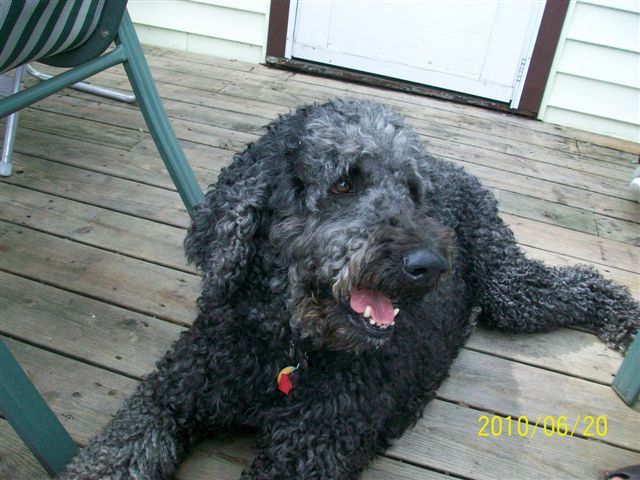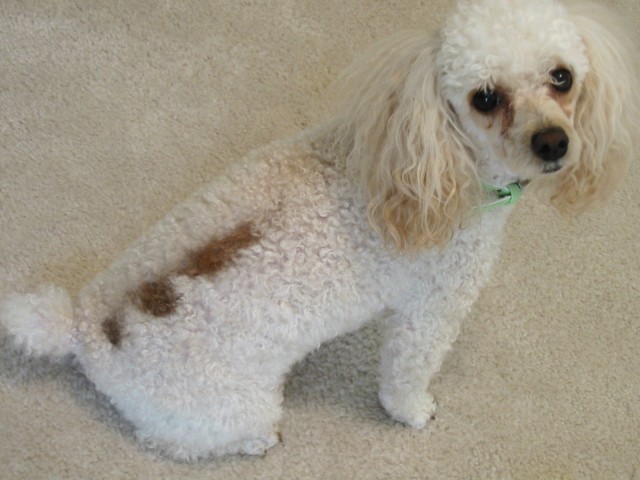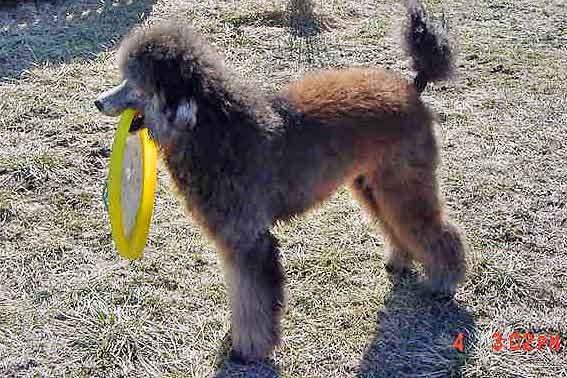QuestionI have a 2 year old male poodle who is not fixed. He has a doggie door he uses most of the time. I still take him out from time to time and always at bed time. He continues to pee on the tile floor that is in the living room and dining room. I find about 2 to 3 spots weekley. What can I do?
AnswerThat could be a challenge to your leadership. Normal housebreaking may not help it. When you are around you need to keep a close eye on the dog. Use closed doors or gates to keep it in the same room as you are, and perhaps as I do, a short chain fastened to the computer desk. If you catch it in the act, give it a sharp ''Ah, ah, ah!'' and take it out. When you can't watch it, crate it.
Other dogs may not be as bad as the young Labs I am plagued with. Still your house and dog will be much safer with the dog in a crate when you are away. The dog may be happier in its den than loose in the house. It relaxes, it feels safe in its den. It rests, the body slows down reducing the need for water and relieving its self. Dogs that have been crated all along do very well. Many of them will rest in their crates even when the door is open. I think the plastic ones give the dog more of a safe, enclosed den feeling. They are harder for dogs to open too. Metal ones can be put in a corner or covered with something the dog can't pull in and chew. Select a crate just big enough for the full grown dog to stretch out in.
Leave it some toys. Perhaps a Kong filled with peanut butter. Don't leave anything in the crate the dog might chew up. It will do fine without even any bedding. You will come home to a safe dog and a house you can enjoy.
A dog that has not been crated since it was little, make take some work. Start out just putting its toys and treats in the crate. Praise it for going in. If you have been able to trust it with any bedding, put that in the crate. Feed it in the crate. This is also an easy way to maintain order at feeding time for more than one dog.
The key to most behavior problems is approaching things using the dog's natural instincts. Dogs see all the people and dogs in the household as a pack with each having their own rank in the pack and a top dog. Life is much easier if the 2 legged pack members outrank the 4 legged ones. You can learn to play the role of top dog by reading some books or going to a good obedience class. A good obedience class or book is about you being top dog, not about rewarding standard commands with a treat. Start at http://www.dogsbestfriend.com/ For more on being top dog, see http://www.dogbreedinfo.com./topdogrules.htm
All of the above may still not solve the problem unless you neuter him. Dogs with behavior problems they can't be trained out of, should never be considered for breeding.

 Haircut/face
Question
No-Shed Fred
We were very lucky to adopt a GRE
Haircut/face
Question
No-Shed Fred
We were very lucky to adopt a GRE
 toy poodle weight
Questiontommy
QUESTION: Hello
I have a 4 month t
toy poodle weight
Questiontommy
QUESTION: Hello
I have a 4 month t
 I am adding a picture for you to view of my toy poodles fur color
QuestionBrandi with spots on h
QUESTION: Kim,
I
I am adding a picture for you to view of my toy poodles fur color
QuestionBrandi with spots on h
QUESTION: Kim,
I
 Chocolate Standard Poodle going grey
QuestionI have a 7 month old chocolate Standard Poodle
Chocolate Standard Poodle going grey
QuestionI have a 7 month old chocolate Standard Poodle
 puppy colors
QuestionI have bred my standard poodle cream bitch with
puppy colors
QuestionI have bred my standard poodle cream bitch with